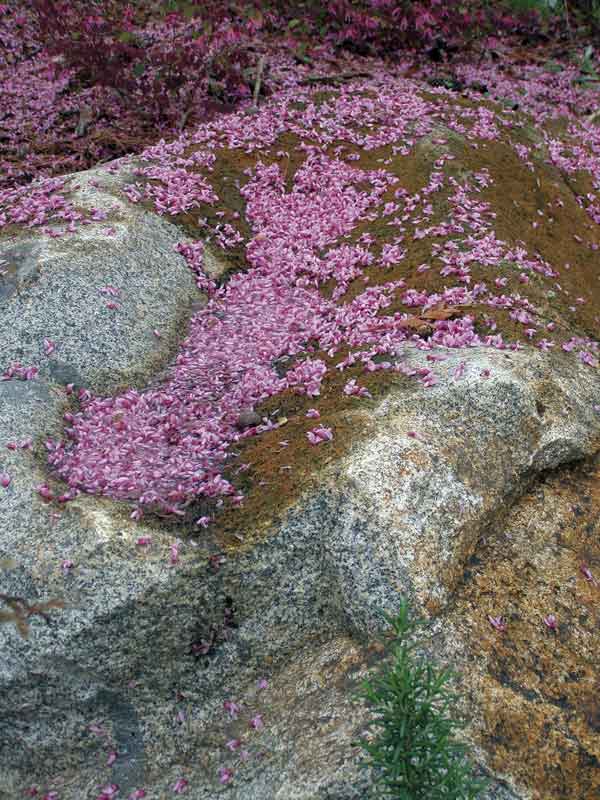
So many favorites
Originally published April 14, 2008

A redbud floral garden carpet. Photo by Ken Moore
By Ken Moore
The cool weather extension of the flowering of native trees and shrubs is resulting in a visual overload. The colorful images range from redbud flowers carpeting the ground, to the spectacle of whole roadside forest edges dripping with pale-violet hanging flower clusters of the deadly, non-native Chinese Wisteria, Wisteria sinensis.
It is impossible for me to describe only one favorite plant this week. As regular readers already know, a favorite is whatever plant has my attention at the moment. One favorite now is Southern Sugar Maple, Acer barbatum, with clusters of tiny yellow-green flowers, in contrast to the earlier, red flowering Red Maple, Acer rubrum. I am enjoying the subtle yellow-green effects illuminating roadsides and urban landscapes everywhere. And I am wondering what advantage flowering later may offer the Southern Sugar Maple, which is so common in our Piedmont bottomland forests. You may enjoy watching the Red Maples release those helicopter seeds later in the spring while the sugar maples hold their flying seeds until the fall.
Also coming into peak flowering is another favorite, the Black Haw, Viburnum prunifolium, a small woodland tree that you may notice along woodland edges where ample sunlight encourages the white, flat-topped flower clusters to cover the tree just before leaf emergence. There is a spectacular specimen towering over the hedge screening the parking area of Carol Woods Retirement Community Building 2. Decades ago, some savvy resident allowed that naturally occurring plant to remain a part of the managed landscape.
The Black Haw is being appreciated by more and more gardeners, and it is beginning to show up in local nurseries featuring native plants. I planted two in full sunlight several years ago, and I enjoy watching the flying saucer-shaped flower bud clusters appear weeks before they achieve peak bloom. The fruit, resembling miniature olives, are a treat for birds in the early fall. This wonderful small tree, very drought tolerant, is common throughout our local woods and is sadly cleared from home sites because builders and homeowners don’t know what they have.
My absolute least favorite plant is so beautiful that many people almost swoon at the visual image. The exotic Chinese Wisteria is feverishly sought out at garden centers for garden arbors and trellises. Please don’t succumb to this deadly vine’s hypnotic beauty. It jumps the fence and invades fields and forests everywhere. I live next door to a five-acre invasion of wisteria, which is slowly killing the forest. Years ago, I learned from experience, when one of those vines strangled a stately pine on the property line; that dead pine subsequently fell and damaged a workshop and storage building. That was a very costly lesson. Local nurseries are now offering the native American Wisteria, Wisteria frutescens, as an appealing non-lethal alternative.
There are many more favorites to describe, but no more room. I hope you will take time to treat yourself to a leisurely walk outdoors this week to discover some of your favorites!
from → Ken Moore's Flora, Spring


Comments are closed.